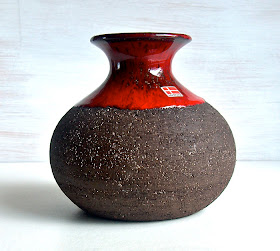
One day I'll get this lovely piece of studio pottery rigged up properly as a table lamp. Because, although it may not look like it, this pot was designed to be a lamp base. There's a hole at the top for the light fitting and a small one at the back for the cable.
The lamp base is hand thrown in red clay and is a fine example of Fishley Holland studio pottery. I would say the lamp base dates from the 1950s or 1960s. The base has a signature W. F. Holland, I think this is for William Fishley Holland who's pottery was at Clevedon, Somerset during this period.
The dark grey background colour is a perfect shade for the pale green raised slip decoration. The wonderful decoration is of leaves and natural forms which are highly stylised and free-flowing.
Personally, I think this pot looks really good just as it is. But when I do find a suitable fitting and a shade, I'll let you see how it looks as a lamp.
There's more on Fishley Holland here: Fishley Holland

















































